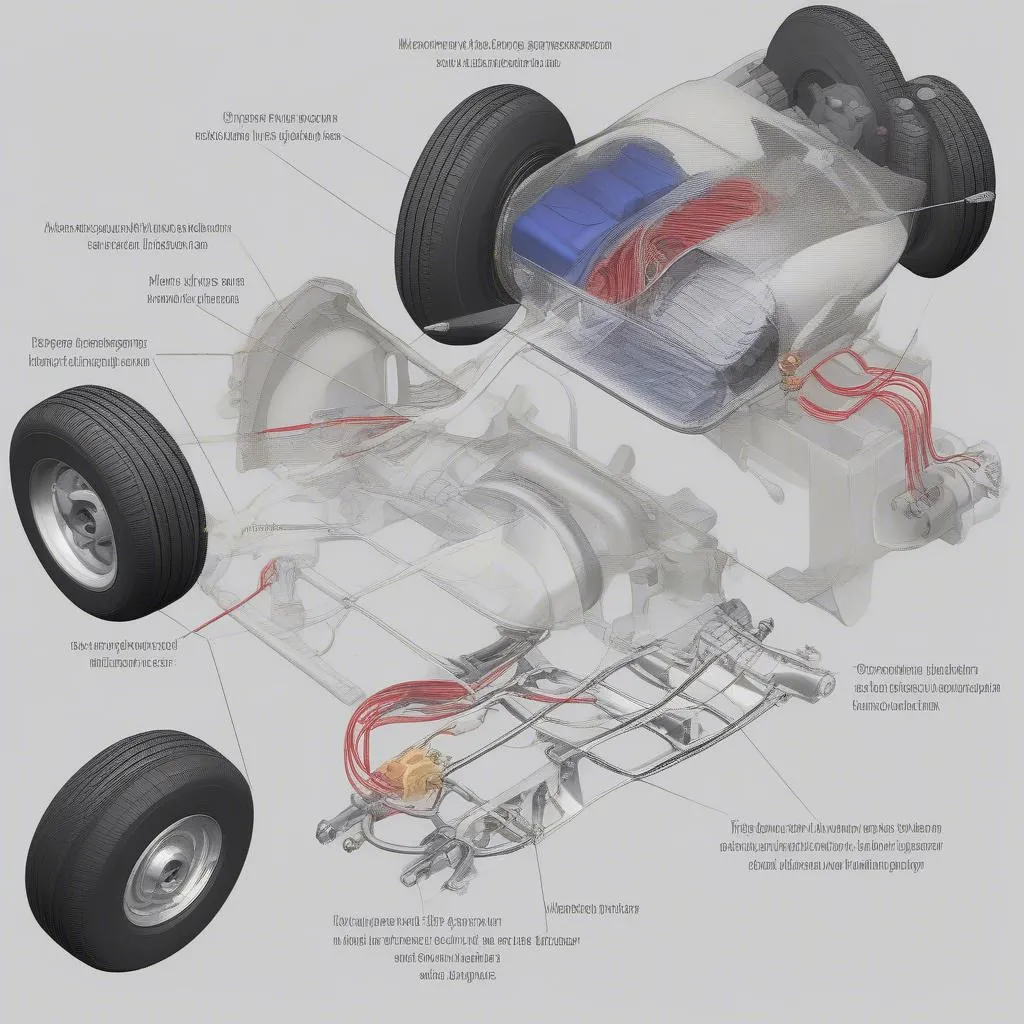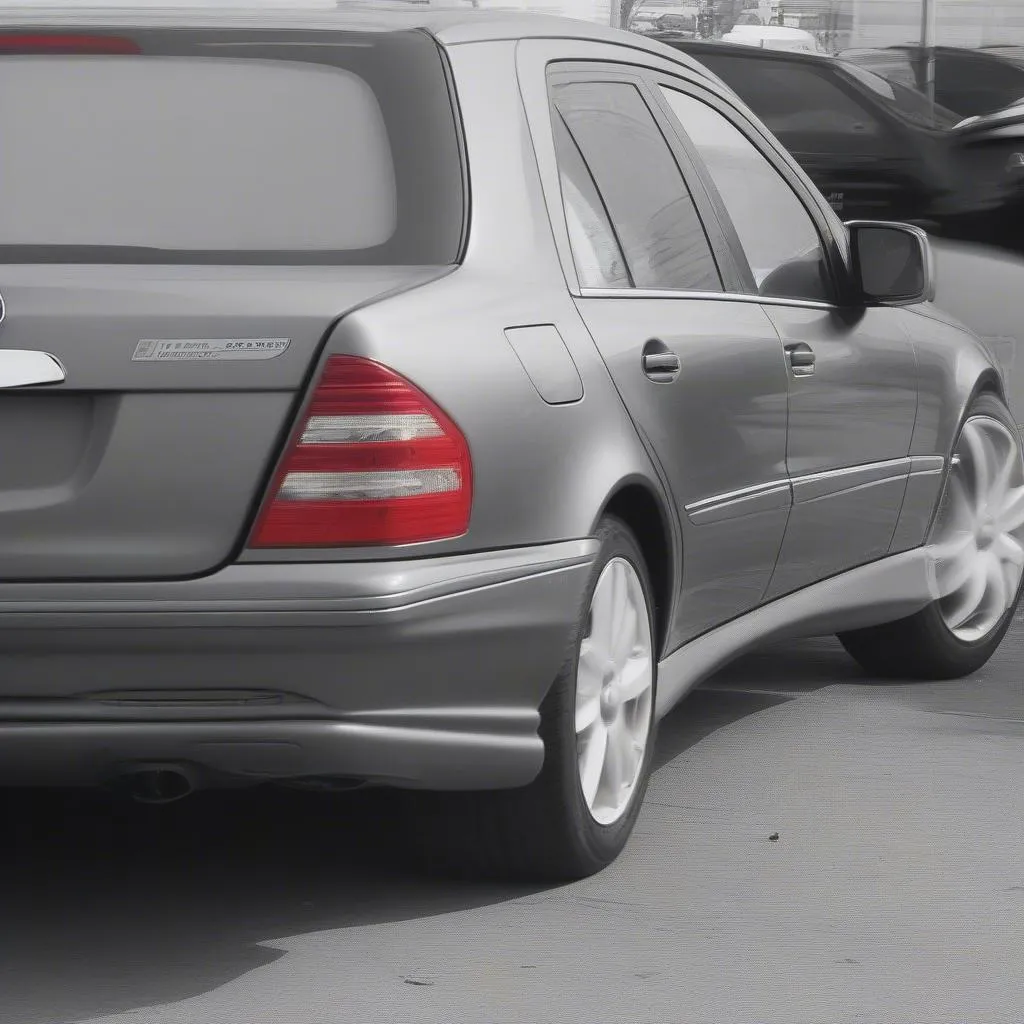If you’re experiencing problems with your Mercedes E500’s rear air suspension, you’re not alone. This is a common issue on these vehicles, but the good news is that it can often be fixed without needing a costly trip to the mechanic. This guide will walk you through some of the most common causes, symptoms, and solutions for addressing rear air bag issues on your Mercedes E500.
Understanding Your E500’s Rear Air Suspension System
Before we dive into troubleshooting, it’s helpful to understand the basics of how your air suspension system works. Unlike traditional steel spring suspensions, the E500’s rear uses air-filled bags to support the vehicle’s weight. These bags are connected to an air compressor, valves, and lines that regulate air pressure, allowing the car to maintain its ride height and provide a smooth, comfortable ride.
 Mercedes E500 Rear Air Suspension Diagram
Mercedes E500 Rear Air Suspension Diagram
Common Causes of Rear Air Bag Problems
There are several reasons why your Mercedes E500’s rear air bags might be giving you trouble:
- Air Leaks: A leak in the air bags, connecting lines, or the compressor itself is the most frequent cause of a sagging rear end.
- Worn Air Bags: Over time, the rubber in your air bags can deteriorate and develop cracks, leading to leaks and reduced performance.
- Faulty Compressor: The air compressor, responsible for pumping air into the system, can wear out or fail, leading to insufficient air pressure.
- Electrical Issues: Problems with the sensors, relays, or wiring within the air suspension system can disrupt its operation.
 Worn Out Air Bag Mercedes E500
Worn Out Air Bag Mercedes E500
Identifying the Problem: Symptoms of Rear Air Bag Issues
Recognizing the signs of a faulty rear air suspension system can save you headaches down the road. Here are some common symptoms:
- Sagging Rear End: One of the most obvious signs is a visibly lower rear end, especially after the car has been parked for a while.
- Uneven Ride Height: If one side of the rear sits lower than the other, it could indicate an air bag problem on that side.
- Compressor Runs Excessively: If you notice your air compressor running more frequently or for extended periods, it’s a sign that it’s working overtime to compensate for a leak or other issue.
- Warning Lights: Your E500 may display a warning message related to the suspension system if it detects a problem.
 Mercedes E500 Sagging Rear Suspension
Mercedes E500 Sagging Rear Suspension
Essential Tools and Equipment
Before you start any repair work, gather the following tools and materials:
- Car Jack and Jack Stands: These are essential for safely lifting and supporting your vehicle.
- Socket Set and Wrenches: You’ll need a variety of sizes to loosen and tighten bolts and fittings.
- Screwdrivers: Both flat-head and Phillips screwdrivers will be necessary.
- Pliers: Useful for gripping and manipulating hoses and clamps.
- Safety Glasses and Gloves: Always prioritize safety when working on your vehicle.
- Leak Detection Spray: Helps pinpoint air leaks in the system (optional).
- Replacement Air Bags (if needed): Ensure you get high-quality, compatible parts.
Troubleshooting and Repairing Your Rear Air Bags
1. Diagnose the Problem:
- Visual Inspection: Carefully inspect the air bags, lines, and compressor for any visible damage, cracks, or signs of wear.
- Leak Detection: If you suspect an air leak, use a soapy water solution or leak detection spray to check for bubbles around suspect areas.
2. Addressing Common Issues:
-
Replacing Leaky Air Bags:
- Disconnect the negative battery terminal.
- Lift and securely support the rear of the car.
- Locate the air line connecting to the faulty air bag and carefully disconnect it.
- Remove the bolts securing the air bag to the suspension and lower control arm.
- Install the new air bag, ensuring all connections are secure.
- Reconnect the air line and lower the vehicle.
-
Replacing a Faulty Compressor:
- Disconnect the negative battery terminal.
- Locate the air compressor, usually found in the trunk or under the rear of the vehicle.
- Disconnect the electrical connector and the air lines leading to the compressor.
- Remove the mounting bolts and extract the old compressor.
- Install the new compressor, ensuring all connections are properly secured.
- Reconnect the battery and test the system.
Important: The steps outlined above are general guidelines. Refer to your Mercedes E500’s service manual for detailed instructions specific to your model year.
Frequently Asked Questions
Q: Can I drive my E500 with a faulty rear air bag?
A: It’s not recommended. Driving with a damaged or malfunctioning air suspension system can lead to further damage and compromise the vehicle’s handling and stability.
Q: How long do Mercedes E500 rear air bags typically last?
A: The lifespan of air bags can vary, but they generally last between 60,000 to 100,000 miles. However, factors like driving conditions, climate, and maintenance can impact their longevity.
Q: Can a diagnostic tool help troubleshoot air suspension problems?
A: Absolutely. A professional-grade automotive diagnostic tool, like those offered by CARDIAGTECH, can read and interpret fault codes stored in your E500’s air suspension control module. This can help pinpoint the root cause of the problem, saving you time and effort during the repair process.
Q: How often should I have my air suspension system inspected?
A: It’s a good idea to have your air suspension system checked during regular maintenance, such as oil changes or annual inspections.
Conclusion
Maintaining your Mercedes E500’s rear air suspension is crucial for a comfortable ride and optimal vehicle performance. By familiarizing yourself with common problems, symptoms, and troubleshooting steps, you can address issues promptly and keep your E500 gliding smoothly down the road. Remember, when in doubt, consulting a qualified Mercedes-Benz technician is always recommended for complex repairs or if you’re unsure about tackling the work yourself.
Expert Insight: “Regular maintenance is key to prolonging the life of your air suspension system,” says automotive expert Jake Carter, author of The Complete Guide to Automotive Air Suspension. “Simple checks, like inspecting for leaks and ensuring proper tire pressure, can go a long way in preventing costly repairs down the line.”

